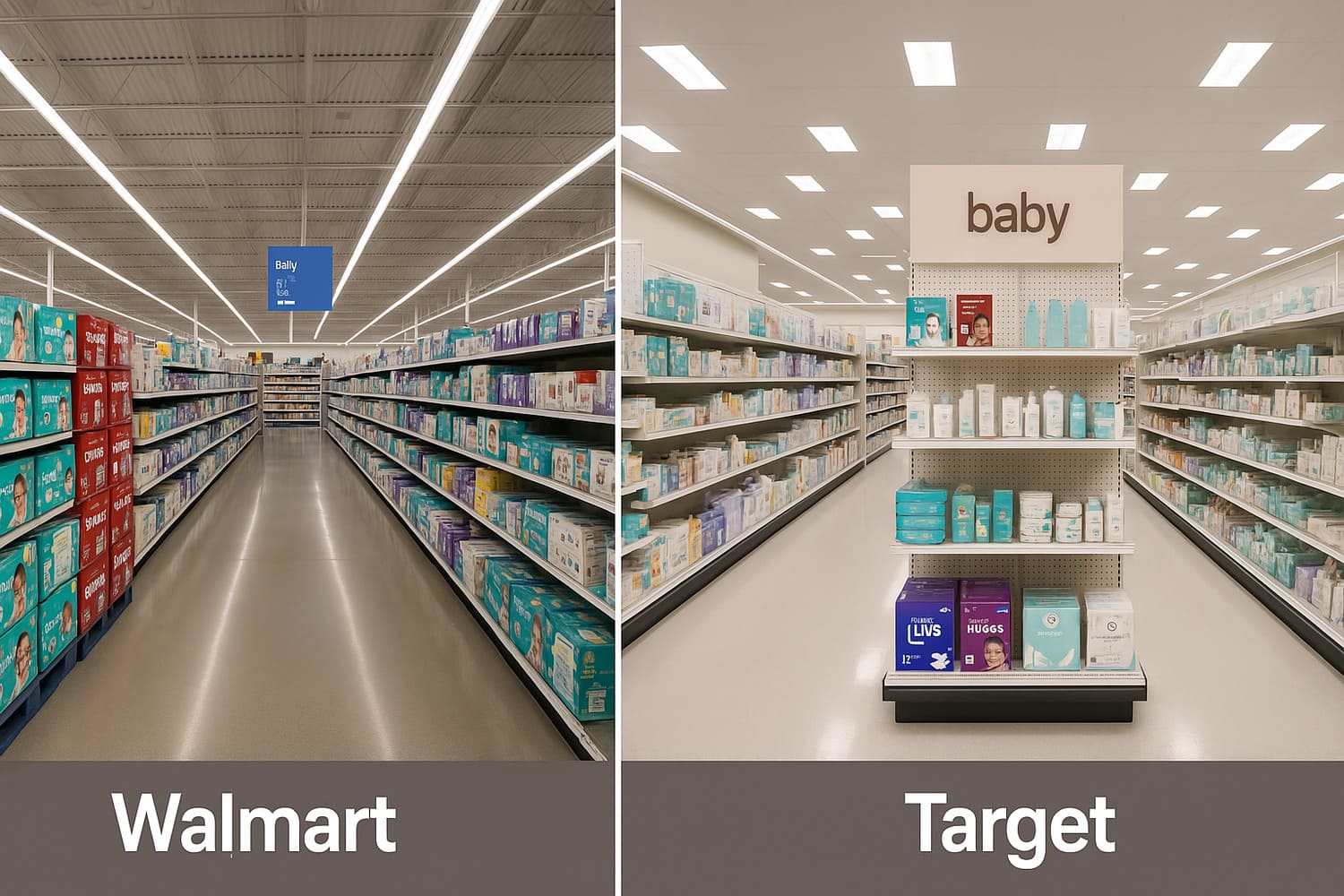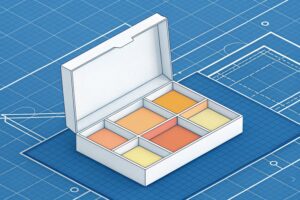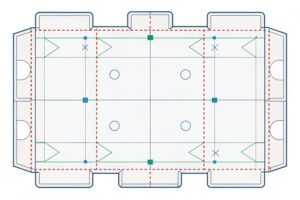Quais são as principais diferenças nos requisitos de exibição de varejo entre o Walmart e a Target for Baby Aisle Products?

O espaço de varejo pode ser altamente competitivo, especialmente em corredores como produtos para bebês. Diferentes varejistas têm requisitos distintos de como os produtos devem ser exibidos. Seja você um fabricante ou um profissional de marketing, entender esses requisitos pode fazer uma diferença significativa na notada seus produtos.
O Walmart e a Target têm padrões específicos de exibição de varejo que variam de acordo com o layout da loja, o comportamento do consumidor e as prioridades corporativas. Saber essas diferenças pode ajudá -lo a projetar melhores exibições adaptadas às necessidades de cada varejista.

Nas seções a seguir, exploraremos essas diferenças, mergulharemos nas quais a loja oferece melhores produtos para bebês, e compartilharemos um guia passo a passo para projetar displays compatíveis com o companheiro nos mercados australianos e dos EUA.
Quais são as diferenças entre o Walmart e o Target?
O Walmart e a Target oferecem vastas seleções de produtos, mas sua abordagem para exibições na loja difere bastante.
O Walmart tende a se concentrar em vendas de alto volume e acessibilidade mais ampla, resultando em designs de exibição mais padronizados. A Target, por outro lado, enfatiza o design e o estilo, criando uma experiência mais esteticamente com curadoria para os compradores.

Abordagem do Walmart
O Walmart, como um dos maiores varejistas do mundo, está mais focado em fornecer soluções econômicas 1 que geram vendas maciças. A loja é geralmente projetada para experiências de compras rápidas 2 , com exibições projetadas para função em vez de formar. Isso significa que em seus corredores de bebê, as exibições tendem a ser mais utilitárias, enfatizando a visibilidade e a rotatividade de produtos 3 . A chave aqui é que as exibições devem manter um alto volume de produtos, facilmente acessíveis para os clientes que procuram ofertas.
Abordagem do alvo
Por outro lado, a Target coloca uma ênfase mais alta na experiência do cliente 4 e na estética. Seus displays de corredor de bebês tendem a ser visualmente atraentes 5 e estrategicamente colocados para incentivar os compradores a demorar mais. O arranjo do produto 6 no alvo geralmente é mais selecionado, com o objetivo de refletir uma experiência que parece atenciosa e acolhedora para os pais e cuidadores. Os produtos do corredor do bebê da Target são frequentemente promovidos em exibições menores e mais atraentes que podem incorporar elementos mais decorativos.
Quem tem melhores coisas de bebê Walmart ou Target?
Quando se trata de produtos para bebês, o Walmart e a Target têm uma vasta gama de ofertas, mas a qualidade e a variedade de marcas geralmente os diferenciam.
A Target é geralmente considerada para oferecer produtos para bebês com curadoria de alto nível, enquanto o Walmart tende a oferecer essenciais mais acessíveis e cotidianos.

Corredor do bebê do alvo
O corredor do bebê da Target é conhecido por transportar marcas premium 7 e uma seleção mais ampla de opções orgânicas ou ecológicas 8 . Muitos pais preferem fazer compras na Target para seus produtos para bebês porque oferecem um equilíbrio de qualidade e estilo. Além disso, a loja geralmente trabalha com marcas de produtos para bebês de alto perfil, oferecendo exclusivos das linhas 9 e da moda que atendem a uma demografia mais sofisticada.
Corredor do bebê do Walmart
O Walmart, no entanto, concentra-se fortemente na acessibilidade 10 , tornando-o um local essencial para os pais preocupados com o orçamento. Embora a variedade nem sempre seja tão sofisticada quanto o alvo, o Walmart oferece grande valor com sua ampla seleção de itens essenciais para bebês 11 , como fraldas, toalhetes, fórmula e comida de bebê. Em muitos casos, os preços do Walmart são mais competitivos, o que pode torná -lo a melhor escolha para as famílias que buscam acessibilidade sobre a seleção de produtos premium.
Como projetar um companheiro compatível para mercados australianos e americanos: um guia passo a passo?
Projetar uma exibição de varejo que possa funcionar nos mercados australianos e americanos exige algumas considerações específicas para os regulamentos, preferências do consumidor e requisitos de armazenamento de cada região.
Para ambos os mercados, sua exibição deve atender aos padrões de conformidade, ser adaptável aos layouts da loja e atrair as preferências culturais de cada região. Abaixo está um guia passo a passo para criar uma tela compatível com Sidekick.

Etapa 1: Pesquise regulamentos locais
Tanto os EUA quanto a Austrália têm regulamentos diferentes quando se trata de embalagem de produtos e conformidade 12 . Nos EUA, varejistas como o Walmart e a Target exigem rotulagem clara nos exibições de produtos 13 , incluindo preços, ingredientes e informações de segurança. Da mesma forma, as lojas australianas têm requisitos específicos em relação à linguagem (por exemplo, os rótulos devem estar em inglês) e certificações de segurança 14 .
Etapa 2: Design com adaptabilidade em mente
O Sidekick Display You Design precisa ser adaptável aos dois mercados. Considere que o Walmart nos EUA pode precisar de telas maiores e mais utilitárias 15 , enquanto os varejistas australianos podem exigir estruturas menores e mais criativas 16 . Planeje sua tela para acomodar ambos usando projetos modulares 17 que podem ser facilmente ajustados com base no tamanho da loja e no espaço disponível.
Etapa 3: Use materiais de alta qualidade
Não importa onde a tela seja colocada, é essencial usar materiais de alta qualidade 18 . Os consumidores nós e australianos esperam durabilidade 19 , especialmente em corredores de tráfego intenso, como seções de bebês. Materiais como papelão resistente 20 , impressão de alta qualidade e embalagens seguras são essenciais para garantir que a exibição esteja no teste do tempo.
Etapa 4: Garanta a conformidade com as expectativas culturais locais
Etapa 4: Garanta a conformidade com as expectativas culturais locais
diferenças culturais 21 desempenham um papel significativo no design de exibição 22 . Por exemplo, nos EUA, os produtos para bebês tendem a ser mais utilitários e focados na função, enquanto na Austrália, a estética pode desempenhar um papel maior. Adapte suas exibições a essas nuances culturais pesquisando as tendências atuais de design 23 nos dois países.
De quais lojas de varejo como Walmart e Target são exemplos?
O Walmart e o Target são exemplos clássicos de varejistas de grandes caixas , que são grandes lojas de estilo de armazém que vendem uma ampla variedade de produtos, variando de mantimentos a bens domésticos e vestuário.
Essas lojas oferecem uma experiência de compra única para os consumidores, geralmente oferecendo preços mais baixos e maiores quantidades de itens.

Características de grandes varejistas
Os varejistas grandes 24, como o Walmart e o Target, têm algumas características definidoras. Eles pretendem oferecer produtos a preços competitivos 25 , geralmente por meio de compras em massa ou marcas de etiqueta privada. Essas lojas também se concentram na conveniência, fornecendo aos clientes uma ampla seleção de itens sob o mesmo teto.
Além disso, esses varejistas têm publicidade em larga escala 26 e orçamentos de marketing, permitindo que eles promovam seus produtos a vastos públicos por meio de vários canais, incluindo Promoções de TV, Online e nas lojas.
Como os varejistas de caixa grande afetam o mercado
A presença de lojas grandes 27 mudou drasticamente o cenário de varejo 28 . Esses varejistas moldaram os hábitos de compras do consumidor, tornando-o comum para as pessoas os visitam para pequenas compras diárias e compras maiores e únicas. As estratégias de exibição 29 desses varejistas podem impactar diretamente como os consumidores interagem e percebem os produtos que compram.
Conclusão
Em conclusão, a compreensão das principais diferenças nos requisitos de exibição de varejo entre o Walmart e a Target pode ajudar os fabricantes e os profissionais de marketing a projetar displays compatíveis e eficazes na atração de clientes. Esteja você segmentando compradores sensíveis a preços no Walmart ou buscando um público mais sofisticado no Target, adaptar sua abordagem de exibição é crucial para o sucesso.
Explore como as estratégias econômicas do Walmart podem beneficiar sua experiência de compra e economizar dinheiro. ↩
Aprenda sobre as estratégias do Walmart para aprimorar a conveniência e a eficiência do cliente nas compras. ↩
Compreender a rotatividade de produtos pode ajudá -lo a entender as estratégias de inventário do Walmart e os esforços de satisfação do cliente. ↩
Explorar esse recurso fornecerá informações sobre estratégias eficazes para melhorar a experiência do cliente, semelhante à abordagem da Target. ↩
Este link oferecerá idéias e técnicas criativas para aprimorar o apelo visual das exibições de varejo, cruciais para atrair clientes. ↩
Descobrir estratégias eficazes de arranjo de produtos pode ajudar os varejistas a otimizar seu espaço e melhorar o envolvimento do cliente, como a Target. ↩
Descubra as principais marcas premium para produtos para bebês que garantem qualidade e estilo, perfeitos para os pais exigentes. ↩
Aprenda sobre as vantagens de escolher produtos de bebês orgânicos ou ecológicos para a saúde e o meio ambiente do seu filho. ↩
Explore linhas de produtos para bebês exclusivas no Target que oferecem itens exclusivos e modernos para o seu filho. ↩
Explorar este link ajudará você a entender como a acessibilidade afeta suas opções de compras para o Baby Essentials. ↩
Esse recurso fornecerá uma lista abrangente de itens essenciais para bebês que todos os novos pais devem considerar a compra. ↩
A compreensão desses regulamentos é crucial para as empresas garantirem a conformidade e evitar multas. Explore este link para insights detalhados. ↩
A rotulagem clara é essencial para a confiança e a segurança do consumidor. Descubra mais sobre seu significado na conformidade do varejo. ↩
As certificações de segurança são vitais para entrada no mercado e segurança do consumidor. Saiba mais sobre os requisitos específicos na Austrália. ↩
A compreensão de exibições utilitárias pode ajudá -lo a criar projetos eficazes que atendam às necessidades práticas em grandes espaços de varejo. ↩
Este link oferecerá idéias inovadoras sobre como as estruturas criativas podem atrair clientes e aprimorar a experiência de compra. ↩
A exploração desse recurso fornecerá informações sobre como os projetos modulares aprimorarão a adaptabilidade e a eficiência em ambientes de varejo. ↩
A exploração desse recurso fornecerá informações sobre como os materiais de alta qualidade aprimoram as exibições de produtos e a satisfação do consumidor. ↩
Compreender o significado da durabilidade pode ajudá -lo a criar exibições que atendam às expectativas do consumidor e suportam o desgaste. ↩
Este link revelará como o papelão resistente pode melhorar a eficácia e a longevidade dos seus monitores de produtos. ↩
A compreensão das diferenças culturais pode aprimorar sua estratégia de design de exibição, tornando -a mais eficaz e atraente para o público local. ↩
Aprender a adaptar o design da exibição às expectativas culturais pode melhorar significativamente o envolvimento e a satisfação do cliente. ↩
A exploração das tendências atuais de design o ajudará a criar exibições que ressoam com seu mercado -alvo e atendem às suas expectativas. ↩
Explore este link para entender os recursos e estratégias exclusivos que definem varejistas de grandes caixas como Walmart e Target. ↩
Descubra como os varejistas de grandes caixas aproveitam as marcas em massa e as marcas de etiqueta privada para manter os preços baixos para os consumidores. ↩
Aprenda sobre o significado de extensos orçamentos de publicidade para atingir vastas públicas e impulsionar as vendas para varejistas de grandes caixas. ↩
Explore como as lojas de grandes caixas influenciam os comportamentos de compras e as tendências do mercado, fornecendo informações sobre as preferências do consumidor. ↩
Descubra as transformações significativas no cenário de varejo devido a varejistas de grandes caixas, moldando o futuro das compras. ↩
Aprenda sobre as estratégias de exibição que aprimoram a interação e a percepção do consumidor, cruciais para o sucesso do varejo. ↩



